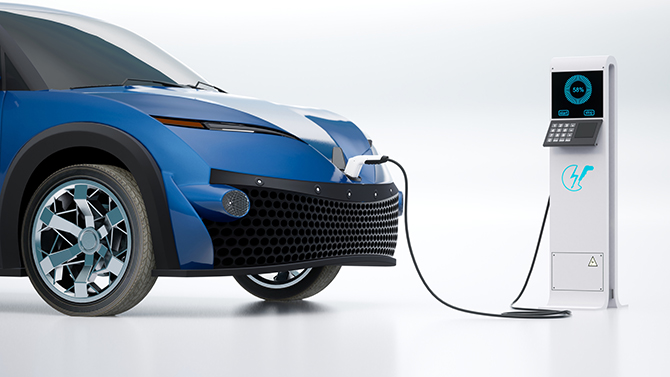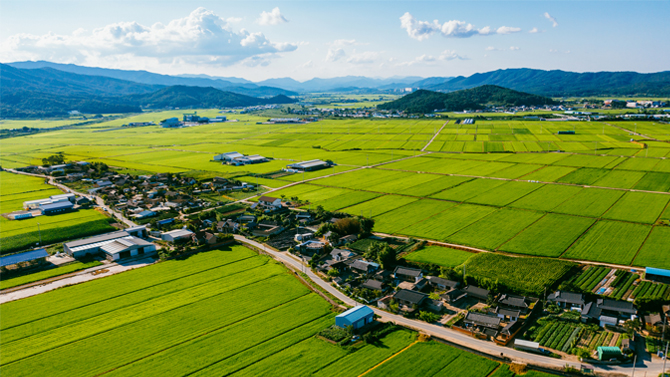Social Issues addressed by Sumitomo —Compass for the Future—
Precision technology to "make, transport, and use" hydrogen
Helping establish a hydrogen value chain for decarbonization
 Climate Change
Climate Change Decarbonization
DecarbonizationSumitomo Precision Products began manufacture of large aluminum alloy plate-fin heat exchangers for cryogenic industrial applications in 1963 and of liquefied natural gas (LNG) vaporizers in 1969. The company has played a key technological role in establishing a value chain in which natural gas is extracted from overseas gas fields, liquefied at coastal facilities, transported by sea as LNG, vaporized at receiving terminals in Japan, and used as natural gas.
Sulfur and other pollutants are removed during the liquefaction process of natural gas. Compared with oil and coal, natural gas emits less CO2 during combustion and has higher power generation efficiency. LNG has been promoted as an essential component of the energy mix since the Oil crisis of 1973 and in Japan it accounts for a large proportion of the power supply mix (37.1% in fiscal 2019).
In April 2022, Sumitomo Precision Products launched a thermal management project team encompassing two businesses, the industrial heat exchanger and the aircraft heat exchanger businesses. Aiming to "promote post-5G and digital society and contribute to the realization of a decarbonized society," the company is stepping up technological development and business expansion in new field by leveraging its technologies cultivated in the field of electronic component cooling and cryogenic fluid, such as electric motor cooling technology, data center cooling technology, and development of hydrogen/ammonia heat exchanger.

In 2017, Japan formulated the world’s first national hydrogen strategy, the Basic Hydrogen Strategy, to address global warming and climate change. In light of the 2050 Carbon Neutrality Declaration, Japan’s sixth Strategic Energy Plan, announced in 2021, envisions that hydrogen and ammonia will account for about 1% of the power mix in fiscal 2030. The Basic Hydrogen Strategy was revised in 2023 to accelerate initiatives for transition to a hydrogen economy. Japan’s targets are to increase the use of hydrogen to 3 million tons/year by 2030 and to approximately 20 million tons/year by 2050. To realize a hydrogen economy, the public and private sectors plan to make investments in the supply chain exceeding 15 trillion yen over 15 years. The process flow of establishing a hydrogen value chain and its social implementation has much in common with that for natural gas at the time of the first imports of LNG to Japan. Demonstrations have been completed for "making" in which hydrogen is liquefied overseas, "transportation" in which it is transported by sea to Japan, and "use" in which hydrogen is vaporized and used.
Sumitomo Precision Products is focusing on the "making" and "use" of hydrogen. With regard to technology for the "use" of hydrogen, the company began manufacture of stainless steel diffusion bonded heat exchangers in 2015. With their high durability for ultra-high-pressure, these heat exchangers has be adopted continuously for hydrogen supply equipment installed at hydrogen charging stations for fuel cell vehicles.
For hydrogen-fueled ships, the company is developing heat exchangers that vaporize liquefied hydrogen. In the aerospace field, development of hydrogen-fueled aircraft has begun, requiring systems and heat exchanger for vaporizing liquefied hydrogen. As social implementation of the liquefied hydrogen supply chain progresses toward 2050, it is expected that even more vaporizers will be needed, and Sumitomo Precision Products will vigorously promote development of new heat exchangers.

In May 2023, Sumitomo Precision Products concluded a joint development agreement with Iwatani Corporation for open rack vaporizers (ORVs) that vaporize liquefied hydrogen. Iwatani is sole liquefied hydrogen supplier in Japan, and is strong in hydrogen sales. Iwatani play a role for establishing a hydrogen supply network and operating liquefied hydrogen receiving terminals in Japan. Iwatani is developing infrastructure equipment to accelerate hydrogen-related business.
Sumitomo Precision Products have delivered a lot of ORVs as LNG vaporizers, and the company had sensed a demand for ORVs as liquefied hydrogen. However, since liquefied hydrogen temperature is even lower at -253 oC compared to LNG at -162 oC, it was necessary to conduct verification test to confirm that ORV could satisfy the performance requirements. The Iwatani R&D Center in Amagasaki City, Hyogo Prefecture, has one of the few liquefied hydrogen testing facilities in Japan. Its proximity to Sumitomo Precision Products’ head office in Amagasaki City facilitated the joint development of ORVs for liquefied hydrogen between the two companies.
Since hydrogen liquefaction reduces the volume to approximately 1/800th, large amounts of hydrogen can be transported by ship and other means. The transported liquefied hydrogen is stored in tank at receiving terminals, vaporized as necessary, and supplied to power plant etc. for use. ORV has a lot of heat exchanger tubes. Seawater flow on the surface of the tubes and liquefied hydrogen is vaporized in the tubes. The technology, originally adopted for LNG vaporizers over half a century ago, is converted to liquefied hydrogen vaporizers. ORVs have outstanding features for high reliability and safety because operating cost is saved since heat source is seawater, and operation and maintenance are easy since components are very simple.
Realizing a decarbonized society and achieving carbon neutrality, it is expected that various markets will expand, such as the use of hydrogen as an energy source, the use of ammonia; the reduction, capture, utilization and storage (CCUS) of CO2 emissions; the development of hydrogen-fueled vehicles, ships, and aircraft; the development of synthetic fuel using hydrogen and CO2; and the technological development of hydrogen reduction steelmaking. Under its slogan, "With precision technologies and precision manufacturing, we innovate the world’s highest quality of precision that supports a sustainable society, ahead of anyone else," Sumitomo Precision Products will continue its quest for the ultimate in precision technologies and precision manufacturing, thereby contributing to the resolution of pressing social issues through its business.


Read about initiatives to achieve a low-carbon society, aiming at net-zero greenhouse gas emissions since these emissions are implicated in global warming.

In view of ongoing globalization and the growing complexity of supply chains, companies need to respond appropriately to issues in supply chains.

The pace of workstyle reform is accelerating as the COVID-19 pandemic has prompted numerous companies to embrace novel ways of working.

For companies, the COVID-19 pandemic has brought the crucial importance of employee health into sharp focus.

Accelerating global warming poses serious business risks. Accordingly, companies need to formulate strategies and implement specific countermeasures from a medium- to long-term perspective.

Spurred by efforts to reduce environmental impacts and in line with increasing social needs, replacement of gasoline-powered vehicles with electric vehicles is accelerating.

Vigorous initiatives are afoot to tackle social issues by revitalizing communities and the interpersonal relationships that bind them together.

Poverty persists in contemporary Japan and the existence of child poverty is a grave concern.

In view of the continuing decline of Japan’s working age population, due to population aging coupled with a low birthrate, development of the next generation is an urgent issue.

The rapid progress in medicine in recent years is largely due to the efforts of not only universities and other research institutions but also of companies to develop cutting-edge technologies.

Numerous initiatives to promote industry and commerce at the regional and community level are underway, involving the use of renewable energy and thus contributing to decarbonization.

One-third of food produced is lost or wasted globally, amounting to about 1.3 billion tons per year. Food loss and waste is a pressing issue in need of a solution.

Companies are addressing a wide range of issues so that people and companies can coexist in harmony with the global environment.

In addition to natural disasters, there are various types of hazards whose nature, incidence and severity are changing with the times. Resilience and flexibility are indispensable in dealing with them.

Read about initiatives to achieve sustainable regional revitalization. The attributes and resources that each region can offer are leveraged to strengthen local economies and overcome the problem of population decline.